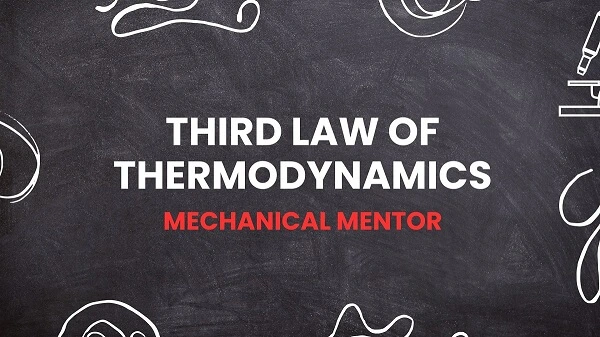The first and second laws of thermodynamics are concerned with thermal processes undergoing cyclicality and also with the conservation of mass and energy depending on the type of thermodynamic system chosen.
The third law of thermodynamics is concerned with the chemically reacting system and is associated with the second law and the concept of absolute entropy.
It is a common observation that as the temperature of a substance decreases, it becomes more crystalline, if not fully. In simple words, when the temperature of a substance is lowered, its molecules start to align themselves in an order, and it results in a quasi-crystalline substance.
So, one can say, yet naively, that on decreasing the temperature of a substance, its entropy decreases unless, at the lowest possible temperature, it reduces to its minimum level.
In this vein, the third law of thermodynamics deals with the entropy of the substances at absolute zero of temperature, that is, 0K or -273.15°C.
It states that:
“The entropy of a pure crystalline substance is zero at 0K”.
The entropy of a non-crystalline substance is non-zero at 0K.
Experimental data support this law and assert that the entropy of a substance is minimal when the temperature approaches 0K.
Application of the Third Law of Thermodynamics
The third law of thermodynamics provides a datum relative to which the entropy of a given substance involved in a reaction can be estimated. The entropy of a substance at any pressure P relative to its entropy at 0K is called absolute entropy.
So, finding out the absolute entropy of a substance at a given pressure and temperature (P, T) would require knowing its absolute entropy under standard conditions of Pref.
The absolute entropy at any stage can be calculated by adding the specific entropy difference between the two states (one with respect to datum and the other with that of at required conditions of P) to the absolute entropy at the standard state.
Hence, if one knows the absolute entropy of a substance with respect to reference pressure Pref. and temperature T, one can find out its absolute entropy at any given pressure P yet at the same temperature as T as follows:
\overset-s(T,P)=\overset-s(T,P_{ref.})+\lbrack\overset-s(T,P)-s(T,\;P_{ref.})\rbrackImplications
There are unique implications of the third law, which are described below:
- For temperature scales, 0K is established as a reference point.
- It points out the theoretical impossibility of achieving absolute zero temperature because doing so would require the withdrawal of all residual energy from the system, which is not possibly actualizable.
- It gives insights into the absolute stability of a crystalline substance when its entropy approaches zero as T approaches zero.
- As the value of entropy at T=0 is known, that is nearly zero for a pure crystalline substance. Using valuable information, one can calculate the change in entropy or absolute entropy of a substance at a given temperature by using empirical (experimental data).
- It helps to understand the overall behavior of entropy or entropy falling trend when the temperature T tends to decrease.
- It helps to study the thermo-chemical changes of a system. It is used to develop better cognizance of cryogenics and superconducting materials at considerably lower temperatures.
- Gibb’s free energy equation, in its special form, implicates the third law and gives useful information regarding the spontaneity of a chemically reacting system or a physical process.
Limitations
There are certain limitations of the third law, which are described below:
- The verification of the third law is quite a challenging task because the attainment of absolute zero temperature is itself a huge challenge.
- The third law predicts the entropy of the crystalline substances at absolute zero temperature. However, it fails to give accurate results proper to entropy in the case of complex materials such as mixtures or non-crystalline substances.
- The datum point for crystalline substances is absolute zero. However, for different substances, this datum is not ideal.
- The entropy value at lower temperatures is calculated through the extrapolations of the experimental data, which ultimately imparts error in the entropy values at lower temperatures.
- At lower temperatures, such as absolute zero, the quantum effects cannot be ignored. The third law does not consider such effects as it is an offshoot of classical thermodynamics.
Gibbs Free Energy Equation and The Third Law
The following expression gives Gibbs the free energy of a reacting system:
\triangle G=\triangle H-T\triangle S
When the temperature of a pure crystalline substance reaches absolute zero, its entropy approaches zero, as asserted by the third law. So, the above expression takes the following form:
As,
T=0
So,
\triangle G=\triangle H
It shows that at absolute zero temperature, the change in free Gibbs energy is equal to enthalpy change only.
Actually, the Gibbs free energy equation decides whether the process would be spontaneous or not. In other words, it decides the direction of a reaching system and acts as an implication of the second law of thermodynamics.
For any chemical reaction,
- If G is negative, it shows the process is spontaneous: products are thermally stable than reactants, and energy would be released at the end.
- If G is positive, it shows the process is not spontaneous: reactants are thermally stable compared to products, and energy would be absorbed during startup.
If G is zero, it shows the process is in the state of thermal equilibrium.
I am the author of Mechanical Mentor. Graduated in mechanical engineering from University of Engineering and Technology (UET), I currently hold a senior position in one of the largest manufacturers of home appliances in the country: Pak Elektron Limited (PEL).
